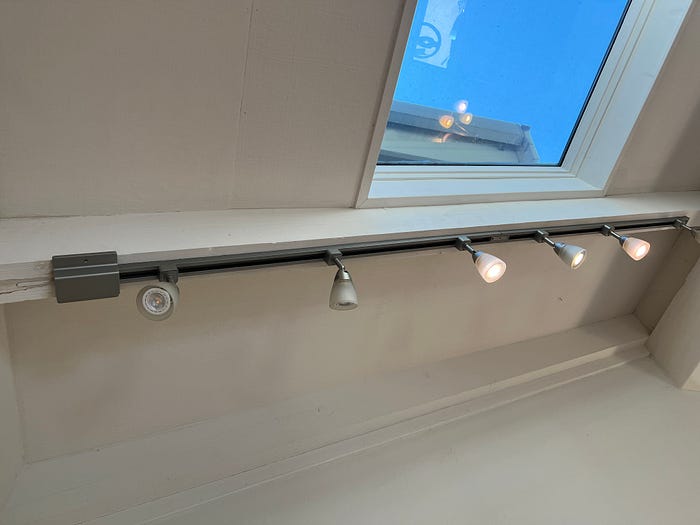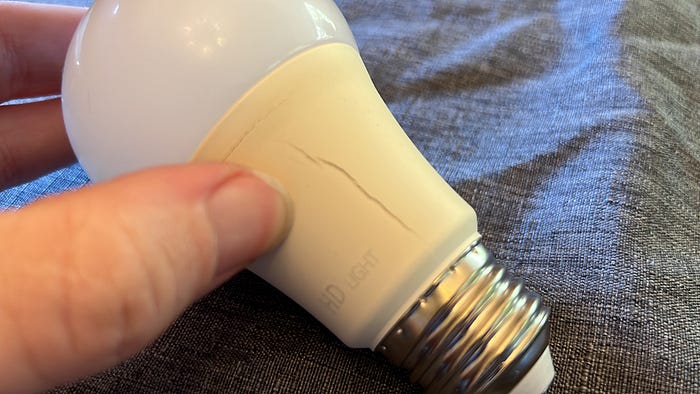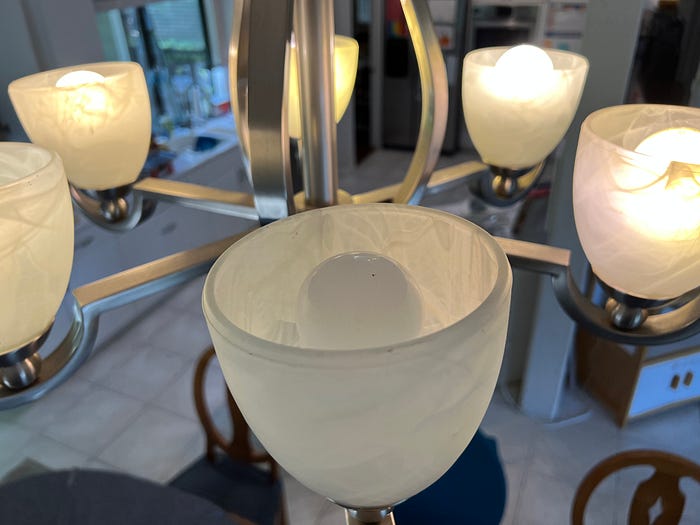According to the package for the LED bulbs I installed when I bought my house three years ago, I shouldn't have to change a lightbulb until my kids are grown, college-educated — and perhaps even married and having kids of their own.
That's because today's LED bulbs claim a lifespan of up to 91 years. Install a bulb today, the packaging suggests, and you might be passing it on to multiple generations of descendants.
The reality, in most cases, is completely different. Despite their outrageous claims, many LED bulbs last only 4–6 years in real-world use.
Half of the fancy LED bulbs I bought three years ago have already burned out. Even more annoyingly, many of the expensive LED bulbs I bought for track lights on my 18-foot ceiling have died as well.
Today's LEDs often fail to deliver on their promises. This harms consumers and the planet. And it's about to get worse. A new Federal law went into effect on August 1st that requires bulbs to emit at least 45 lumens per watt of power used. Although it's not officially an incandescent ban, the law makes efficient lightbulbs like LEDs a de-facto requirement in the United States, and most incandescent bulbs will no longer be eligible for sale.
Why the huge discrepancy between advertised lifespans and reality? There are several factors at play. Understanding them is key to navigating the LED transition in a way that makes use of potentially world-changing LED technology without leaving consumers angry — or damaging the planet.
The Claim
Today's top-of-the-line LEDs have an advertised lifespan of up to 100,000 hours. If you use the bulb for 8 hours per day (say, you put the bulbs in an often-used lamp in your living room), that works out to 12,500 days or 34 years of use.
For less-used bulbs, the claimed lifespan could be even longer. Imagine that you use new LED bulbs in your bathroom for 3 hours per day, and they have a lifespan of 100,000 hours. That's about 91 years of use.
There are indeed lightbulbs that have burned for over 100 years. The world's most famous lightbulb is located about 20 miles from me in Livermore, California. It's burned continuously for over 120 years and is a beautiful sight to behold.
But will a run-of-the-mill LED bulb purchased today actually work for that long?
The Reality
The reality is often far different. In my own experience, most of my LED bulbs last between 2 and 5 years.

New York Magazine recently shared that when the Metropolitan Museum replaced its incandescent bulbs with LEDs, they expected the new bulbs to last at least 7 years. In reality, they failed far earlier than that.
And worse, they failed in unpredictable ways. Incandescent bulbs simply burn out when their life is done, but LEDs can gradually produce less light, start to randomly pulse or flicker, or even change color. The bulb can appear to still be producing light, but the light quality or color temperature can be terrible.
In a bizarre recent example, some supposedly long-life LED streetlights started to turn purple well before their time. On a recent visit to a luxury hotel, I saw maintenance people swapping out LED bulbs that had inexplicably turned blue.
With LEDs, we were promised bulbs that would last a lifetime. Instead, what we've often got are duds that last only marginally longer than their incandescent predecessors.
What's Happening?
Why don't LED bulbs live up to their lifespan hype? A big part of the issue with today's LED bulbs lies in how they're tested.
The standard today is based on "lumen maintenance." According to the Department of Energy, an LED is considered to have reached the end of its lifespan when its light output (measured in lumens) has decreased by 30%.
As the DOE acknowledges, though, it's impossible to accurately test the actual lifespan of today's LED bulbs. Doing so would potentially require leaving the bulb illuminated continuously for 11.4 years if the 100,000-hour claimed lifespan proved true. It's not practical to make companies test their products for a decade before bringing them to market.
So the DOE lets manufacturers take shortcuts. It allows LED makers to test their bulbs for as little as 6,000 hours, and extrapolate out the results based on that.
A manufacturer could, for example, test a new bulb for 6,000 hours (about 8 months), observe that its light output decreased by 0.5% over that period, and use that data to project that the bulb will take 50+ years to lose the remaining 29% of its brightness.
As consumers are fast discovering, though, those projections don't hold up in the real world.
Eight months of illumination might be enough to determine how quickly the actual LED in a lightbulb loses brightness. But "lumen maintenance," says very little about how long the whole bulb will last in the real world.
LED bulbs consist of the LED itself, but also myriad other components — a voltage converter, heat sinks to dissipate waste heat, driver circuitry, dimmer circuitry, in some cases Wi-Fi and Bluetooth modules, a plastic casing, and much else.
All those components add complexity and points of failure. According to the DOE's own data, non-LED components like driver circuitry accounts for 60%+ of bulb failures. And eight months is not nearly long enough to determine which of those myriad components will fail, and when.
It's possible, for example, that an LED could indeed burn for 90 years. But that's meaningless if the bulb's plastic housing cracks after 3 (this is what happened to my own bulbs), or its driver circuit fries due to a power surge at year 5.

Exacerbating these issues are the challenges LED bulbs face in real-world use. Heat, for example, can dramatically shorten a bulb's lifespan. Using an LED bulb in a poorly designed — or simply old — fixture that doesn't properly dissipate heat could kill a 90-year bulb in a few years. If sunlight hits an LED bulb, that can also shorten its life.
Likewise, many LEDs require dedicated dimmer circuitry. Most consumers, blissfully unaware of these requirements, cheerfully use their LEDs with improper dimmers. This puts strain on the bulb, shortening its life.
Again, none of these issues show up in laboratory testing, where bulbs are evaluated for just a few months under perfect conditions. The DOE's testing procedures explicitly say "unusual environmental conditions, such as thermal interference from heating, ventilation, and air conditioning systems or solar loading, are to be reduced to levels reasonably expected to minimize influence" during testing.
In other words, the testing procedure itself is designed specifically to ignore the kinds of real-world factors that might reduce a bulb's actual lifespan.
Today's standards for testing LEDs are a bit like buying a brand-new car, driving it on a perfectly flat road for 1,000 miles, seeing that its transmission has barely worn down, and then projecting that the whole car will last 70 years with zero maintenance based on that finding.
Sure, the transmission might be in great shape after 1,000 miles on a flat road. But that says nothing about how it will wear after 50,000 miles of real-world driving. Nor does it tell you anything about what will happen to the rest of the car.
Because LED testing requirements don't accurately reflect how the bulbs are actually used, they result in wildly inaccurate lifespan estimates that leave consumers feeling deceived.
The Impact
The lifespan failings of LED bulbs aren't just an annoyance — they're an environmental issue.
Traditional incandescent bulbs are simple and non-toxic — they're made from bits of glass, some metal, and a tungsten filament. When they burn out, you can safely discard them in your normal trash can.
Dead LED bulbs, on the other hand, are e-waste. Like old computers, they contain chips and other electronics that need to be properly recycled by a professional e-waste processor. If they're sent to a traditional landfill, they can potentially leach dangerous chemicals into the soil.
The reality, though, is that many consumers chuck their dead LED bulbs into the normal garbage and go about their day. This wouldn't be as big a deal if LEDs genuinely lasted 50+ years.
But because they actually burn out in 4–6 years, that means consumers are likely throwing away millions of these dead bulbs every year. A recent paper estimated that in Canada alone, consumers send 26 million pounds of spent LED bulbs to improper landfills yearly. That's a huge amount of potentially dangerous e-waste that's going right into the environment.
There are other issues, too. Many light fixtures are now being designed with "integral LEDs." This means that the LED bulb can't be changed; it's built into the body of the fixture itself.
Again, that would be fine if the bulb lasted decades. But if it burns out in five years, consumers won't just need to throw away a spent bulb — they'll need to rip out and throw away an entire fixture. That creates even more unnecessary waste — not to mention expense.
Several years ago, I had to hire an electrician to remove an integral LED fixture that had failed. Removing and replacing a single fixture cost almost $200.
What to Do
Given LED bulbs' failure to live up to claims about their lifespans, both consumers and regulators need to make drastic changes in how they market and use these bulbs.
- For starters, manufacturers shouldn't be able to make lifespan claims based on 8 months of brightness testing in ideal laboratory conditions. In projecting the lifespan of their bulbs, they should be required to take into account real-world use factors, like the impact of temperature, the probable lifespan of the bulb's non-LED components, and more.
- Additionally, they should be required to update their claimed lifespans based on real-world data from consumers. If a company claims that its bulb lasts 30 years, but hundreds of consumers report that it only lasts four, the manufacturer should be required to update their lifespan claim accordingly.
- Regulators should require manufacturers to provide a warranty equal to the full claimed life of the bulb. Many bulb makers claim their bulbs will last 10+ years, but only warrant them for 3–5. That's a huge red flag. If manufacturers truly believe their own lifespan claims, they should offer a warranty equal to the rated lifespan of their bulb.
- Waste management agencies need to do a better job of educating consumers about the proper disposal of dead LED bulbs, and provide easier ways for consumers to responsibly dispose of the e-waste that these bulbs create.
- LED bulbs can be repaired. Regulators should encourage the development and sale of modular/repairable LED bulbs as an alternative to disposable ones.
As a consumer, you can take some important steps, too:
- Don't believe the claimed lifespan on your fancy new box of LED bulbs. No matter what a manufacturer says, you can assume your bulbs will last at most about 6–7 years in real-world conditions. Plan accordingly, both for replacing the bulbs and for disposing of them responsibly when they fail.
- Be leery of integral LED fixtures. I had fancy integral LED lights installed in my bathroom before I fully understood the potential risks. I hope they meet their claimed lifespan of 25,000 hours. But I'm not terribly optimistic.
- Contact your waste management company and ask about your nearest Household Hazardous Waste disposal facility. Check if they accept old LED bulbs. You can also check your local Lowes or Home Depot, many of which have bulb recycling programs. Earth911 has a list of mail-in LED recycling programs, too.
- Buy the highest quality LED bulbs you can afford. While my inexpensive LED bulbs failed quickly, I have pricier bulbs from manufacturers like Philips Hue that are still burning after almost 10 years. You'll pay more upfront, but you may save money in the long term because you'll need to replace bulbs less often, and you'll create less e-waste.
- As new laws about bulb efficiency come into effect, expect to see cheap, low-quality LED bulbs flood the market. Because of how today's testing procedures work, these bulbs will be able to claim decades-long lifespans based on a few thousand hours of testing. Stay away.
To be clear, LED bulbs aren't bad — they're a hugely impactful technology that will be pivotal to the shift to a greener, less carbon-intensive economy. A single LED bulb can save 451 pounds of carbon emissions per year. Even if LED bulbs last only 4–6 years, they will still save thousands of pounds of CO2 for every bulb installed.
Even so, consumers deserve to understand exactly how long their LED bulbs will actually last. Outrageous claims based on unrealistic testing procedures can leave consumers feeling tricked, and risk souring them on the whole idea of switching to LEDs. The issue will only get worse as lower-quality LEDs flood the Amazon and Targets of the world now that the new Federal bulb law is in effect.
Better lifespan estimates and more realistic testing procedures will ensure that only the highest-quality LED bulbs — with the highest chance of burning for a decade or more — can make it into discerning consumers' homes.
Accurate lifespan estimates will also allow consumers to plan ahead for replacing bulbs and disposing of spent LEDs in an environmentally responsible way. And it will let consumers buy truly longer-lasting LED bulbs that will produce less e-waste over the long term.
That could mean the difference between an LED transition that saves billions of tons of carbon emissions and one that fails, leaving consumers feeling alienated by (and angry) at an otherwise world-changing green technology.


